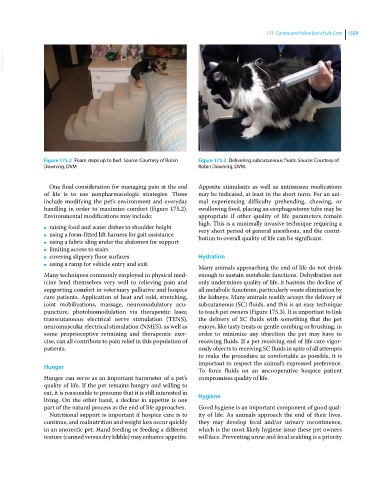Page 1621 - Clinical Small Animal Internal Medicine
P. 1621
175 Canine and Feline End of Life Care 1559
VetBooks.ir
Figure 175.2 Foam steps up to bed. Source: Courtesy of Robin Figure 175.3 Delivering subcutaneous fluids. Source: Courtesy of
Downing, DVM Robin Downing, DVM.
One final consideration for managing pain at the end Appetite stimulants as well as antinausea medications
of life is to use nonpharmacologic strategies. These may be indicated, at least in the short term. For an ani-
include modifying the pet’s environment and everyday mal experiencing difficulty prehending, chewing, or
handling in order to maximize comfort (Figure 175.2). swallowing food, placing an esophagostomy tube may be
Environmental modifications may include: appropriate if other quality of life parameters remain
high. This is a minimally invasive technique requiring a
raising food and water dishes to shoulder height
● very short period of general anesthesia, and the contri-
using a form‐fitted lift harness for gait assistance
● bution to overall quality of life can be significant.
using a fabric sling under the abdomen for support
●
limiting access to stairs
●
covering slippery floor surfaces Hydration
●
using a ramp for vehicle entry and exit.
Many animals approaching the end of life do not drink
●
Many techniques commonly employed in physical med- enough to sustain metabolic functions. Dehydration not
icine lend themselves very well to relieving pain and only undermines quality of life, it hastens the decline of
supporting comfort in veterinary palliative and hospice all metabolic functions, particularly waste elimination by
care patients. Application of heat and cold, stretching, the kidneys. Many animals readily accept the delivery of
joint mobilizations, massage, neuromodulatory acu- subcutaneous (SC) fluids, and this is an easy technique
puncture, photobiomodulation via therapeutic laser, to teach pet owners (Figure 175.3). It is important to link
transcutaneous electrical nerve stimulation (TENS), the delivery of SC fluids with something that the pet
neuromuscular electrical stimulation (NMES), as well as enjoys, like tasty treats or gentle combing or brushing, in
some proprioceptive retraining and therapeutic exer- order to minimize any objection the pet may have to
cise, can all contribute to pain relief in this population of receiving fluids. If a pet receiving end of life care vigor-
patients. ously objects to receiving SC fluids in spite of all attempts
to make the procedure as comfortable as possible, it is
important to respect the animal’s expressed preference.
Hunger
To force fluids on an uncooperative hospice patient
Hunger can serve as an important barometer of a pet’s compromises quality of life.
quality of life. If the pet remains hungry and willing to
eat, it is reasonable to presume that it is still interested in Hygiene
living. On the other hand, a decline in appetite is one
part of the natural process as the end of life approaches. Good hygiene is an important component of good qual-
Nutritional support is important if hospice care is to ity of life. As animals approach the end of their lives,
continue, and malnutrition and weight loss occur quickly they may develop fecal and/or urinary incontinence,
in an anorectic pet. Hand feeding or feeding a different which is the most likely hygiene issue these pet owners
texture (canned versus dry kibble) may enhance appetite. will face. Preventing urine and fecal scalding is a priority

